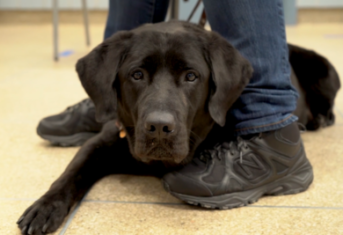Take a trip through a dog’s lungs with bronchoscopy

Take a trip through a dog’s lungs with bronchoscopy
Endoscopy is a general term for a procedure looking inside the body with a tiny camera on the end of a flexible tube. The flexible tube has channels to allow various devices to travel through the channel and exit inside the body. These devices perform various tasks, such as sample cells with a brush, remove a bite of tissue for a biopsy, snare a polyp or remove an accidentally ingested foreign object. Specific words are used to describe endoscopy of a particular body part: arthroscopy for joints, cystoscopy for the bladder, colonoscopy for the colon. Bronchoscopy refers to endoscopic examination of the breathing tubes or bronchi. It’s often coupled with evaluation of the larynx and trachea (laryngoscopy and tracheoscopy). In this blogpost, we’ll take a closer look at endoscopy of the canine respiratory system.
Bronchoscope
A bronchoscope is a specialized piece of equipment used to perform endoscopic evaluation of the respiratory tree. It’s a long, flexible device manipulated by a handheld control. At the Animal Medical Center, the bronchoscope’s camera projects onto a screen in the endoscopy suite. The patient must be under general anesthesia for the procedure because one chomp from a dog’s teeth would puncture the bronchoscope’s waterproof coating.

The Larynx
The larynx, or voicebox (or maybe more appropriately the barkbox), is easily seen during bronchoscopy. The larynx has a mobile right and left side called the arytenoid cartilage. In between the flaps is the opening to the trachea, or windpipe. These flaps open when your dog breathes and close when your dog swallows to prevent food from going “down the wrong pipe.”

The Trachea
The trachea, or windpipe, is a semi-rigid tube supported by rings of cartilage. In the photo here, you can easily see the ridges formed by the cartilage rings as you look down into the trachea. This trachea shows no sign of a common canine disorder called tracheal collapse.

The Bronchi
The trachea branches into smaller tubes called bronchi. The photo shows a left and right branch of a bronchus and inside the left branch you can see another branching point. The actual lungs themselves surround the bronchi and cannot be seen on endoscopy. This dog has normal bronchi with no signs of infection or inflammation.

The Choanae
Most have never heard of these side by side openings. They are the exit of the right and left nasal passages into the back of the throat. Put differently, they are the source of post nasal drip. To see them, the bronchoscopist makes a U-turn with the bronchoscope, looking back towards the front of the head rather than down into the larynx and trachea.
At the AMC, our Internal Medicine specialists perform bronchoscopy to diagnose and treat a variety of respiratory conditions. If your dog has a cough, something stuck in its windpipe or pneumonia, bronchoscopy will be a helpful diagnostic tool to get your favorite fur person well.































